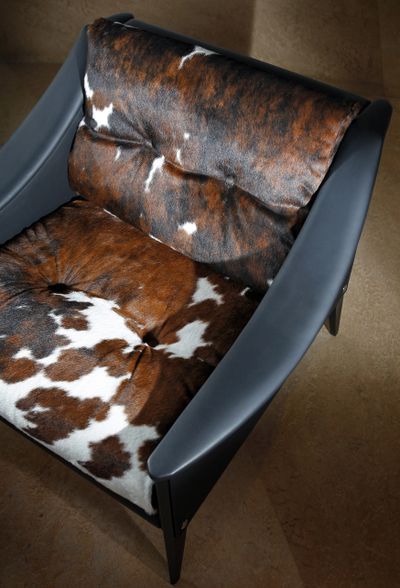From upholstery to accessories, leather perfect across home

KANSAS CITY, Mo. – Whether it resembles a well-traveled saddle or a buttery smooth burst of cherry red or lime green, leather furniture is classic and strong.
As upholstery, leather lasts four times as long as fabric, according to American Leather. The Dallas-based manufacturer creates furniture in fabric and leather for stores including Crate & Barrel, Design Within Reach and Macy’s.
“Try to tear this,” says Lonnie McDonald of Grandview, Mo., holding a tanned leather hide. He cleans, repairs and refinishes leather furniture and leads maintenance sessions for the Leather Pro division of the Textile Care Group. He has served as liaison between the American furniture and cleaning industries to rewrite labels on leather care.
The leather in McDonald’s hands is resistant. “It has a tensile strength of more than 200 pounds per square inch,” he says. “So yes, it’s durable.”
Doctors also recommend leather furniture for allergy sufferers because fabric harbors dust mites. Besides swapping carpet for tile or wood flooring, the Mayo Clinic’s website recommends replacing fabric-upholstered items such as sofas, chairs and headboards with leather.
The look and feel of leather are the characteristics that draw most people. For more than two decades, Steve Maturo has sold leather furniture at Museo, a midtown store in Kansas City, Mo. He has a 20-year-old black leather sofa and Mario Bellini leather dining chairs in his own home.
“They get better – and better-looking – with age,” Maturo says.
In Europe, leather is used in wall coverings, flooring, tables and even countertops. Maturo and Museo employees have toured leather furniture factories in Italy and the Netherlands. The experience has given him an appreciation for how each cowhide is unique, similar to fingerprints and wood grains. Under a magnifying glass, you can even see pores.
Leather is so comfortable and soothing because it is skin, McDonald says. Through the natural process of transpiration, leather absorbs and releases moisture through fibers and pores. Leather can absorb and release about 15 percent of its weight in water. And it becomes more supple and comfortable with use.
However, leather furniture is not for everyone. For starters, it costs 25 percent to 50 percent more than fabric upholstery. Because of the expense and lifestyle considerations, interior designer Sallie Kytt Redd of Lenexa, Kan., isn’t a fan.
“Buckles in children’s shoes can scratch and puncture it,” she says. “In the summer, if you have bare legs, it can feel sticky, even in an air-conditioned room. And it’s not cuddly and warm in the winter; it’s stiff. I don’t have many clients who use leather.”
On the plus side, Redd says leather can simply be wiped off, and it does look nice. Occasionally her clients will insist on leather. One bought a dark, smoky blue leather lounge chair and ottoman that were things of beauty.
“But a year later, I got a call from the client who said he needed a different chair, something in fabric,” Redd says. “Leather is slippery. If you have posture issues, it just doesn’t allow you to sit straight up.”
McDonald appreciates the positive characteristics of leather and owns a leather sofa with fabric seat cushions. Over the years he has learned the tricks of the trade and is now teaching others. For example, if a ballpoint pen leaves a tiny ink mark on nubuck leather, you can lightly sand it and feather it out to camouflage the stain. (Don’t try this on aniline or pigmented leathers.)
The biggest problem McDonald sees is that people tend not to clean their leather and protect it from body oil stains on head and arm rests.
“Leather is the Mercedes of furniture,” he says. “My dad was a mechanic, and he taught me that when you take care of a car, it lasts longer.”
Although leather is a luxury product, sales were up 20 percent in 2011 at American Leather, spokeswoman Jennifer Green says.
Customers are looking for more environmentally friendly furniture. Modern tanneries now use closed-water systems and private water treatment plants to prevent the pollution of surrounding water supplies. At American Leather, the dying process involves water-based products that are chrome-free.
Trends in leather include gray as a neutral as well as metallic and pearl finishes.
And cowhide in furniture upholstery and rugs transcends wild West looks.
“They add texture and warmth whether they’re in downtown lofts, (suburban) houses or country kitchens,” says Fancy Smith, owner of home furnishings store Cactus Creek in Weston, Mo.
Cowhide rugs at the store are typically $250. “They’re good on their own or as a layer with another rug on carpet,” Smith says.
High-quality versions can take a beating, too. She has spilled red wine and food on them, which can be wiped off with a damp rag and then vacuumed. When a customer spilled hot wax on a rug, Smith removed it with a fine-tooth comb.
“They look so beautiful and exotic,” Smith says. “But they come from cows that we see every day.”